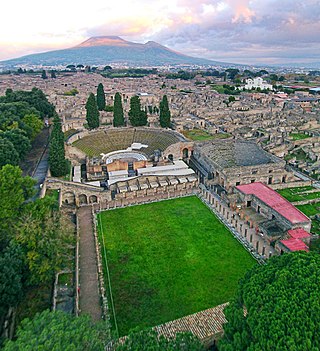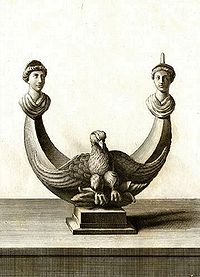
A Roman villa was typically a farmhouse or country house in the territory of the Roman Republic and the Roman Empire, sometimes reaching extravagant proportions.

Giovanni BattistaPiranesi was an Italian classical archaeologist, architect, and artist, famous for his etchings of Rome and of fictitious and atmospheric "prisons". He was the father of Francesco Piranesi, Laura Piranesi and Pietro Piranesi.

The Villa of the Papyri was an ancient Roman villa in Herculaneum, in what is now Ercolano, southern Italy. It is named after its unique library of papyri scrolls, discovered in 1750. The Villa was considered to be one of the most luxurious houses in all of Herculaneum and in the Roman world. Its luxury is shown by its exquisite architecture and by the large number of outstanding works of art discovered, including frescoes, bronzes and marble sculpture which constitute the largest collection of Greek and Roman sculptures ever discovered in a single context.

The National Archaeological Museum of Naples is an important Italian archaeological museum, particularly for ancient Roman remains. Its collection includes works from Greek, Roman and Renaissance times, and especially Roman artifacts from the nearby Pompeii, Stabiae and Herculaneum sites. From 1816 to 1861, it was known as Real Museo Borbonico.

The Secret Museum or Secret Cabinet in Naples is the collection of 1st-century Roman erotic art found in Pompeii and Herculaneum, now held in separate galleries at the National Archaeological Museum in Naples, the former Museo Borbonico. The term "cabinet" is used in reference to the "cabinet of curiosities" - i.e. any well-presented collection of objects to admire and study.
Andrew Frederic Wallace-Hadrill, is a British ancient historian, classical archaeologist, and academic. He is Professor of Roman Studies and Director of Research in the Faculty of Classics at the University of Cambridge. He was Director of the British School at Rome between 1995 and 2009, and Master of Sidney Sussex College, Cambridge from August 2009 to July 2013.

Boscoreale is an Italian comune (municipality) and town in the Metropolitan City of Naples, Campania, with a population of 25,939 in 2022. Located in the Vesuvius National Park, under the slopes of Mount Vesuvius, it is known for the fruit and vineyards of Lacryma Christi del Vesuvio. There is also a fine Vesuvian lava stone production.

Pompeii and Herculaneum were once thriving towns, 2,000 years ago, in the Bay of Naples. Both cities have rich histories influenced by Greeks, Oscans, Etruscans, Samnites and finally the Romans. They are most renowned for their destruction: both were buried in the AD 79 eruption of Mount Vesuvius. For over 1,500 years, these cities were left in remarkable states of preservation underneath volcanic ash, mud and rubble. The eruption obliterated the towns but in doing so, was the cause of their longevity and survival over the centuries.
Karl Jakob Weber was a Swiss architect and engineer who worked under the orders of the Spanish military engineer Roque de Alcubierre in the excavations of Herculaneum Herculaneum, Pompeii and Stabiae, under the patronage of Charles VII of Naples. At first a soldier and military engineer, he joined the excavations in 1749. His detailed drawings provided some of the basis for the luxurious royal folios of Le Antichità di Ercolano esposte, by means of which the European intelligentsia became aware of the details of what was being recovered.
The decade of the 1700s in archaeology involved some significant events.
The decade of the 1730s in archaeology involved some significant events.
The decade of the 1750s in archaeology involved some significant events.
The decade of the 1780s in archaeology involved some significant events.
The decade of the 1790s in archaeology involved some significant events.

Pompeii was a city in what is now the municipality of Pompei, near Naples, in the Campania region of Italy. Along with Herculaneum, Stabiae, and many surrounding villas, the city was buried under 4 to 6 m of volcanic ash and pumice in the eruption of Mount Vesuvius in 79 AD.

Stabiae was an ancient city situated near the modern town of Castellammare di Stabia and approximately 4.5 km southwest of Pompeii. Like Pompeii, and being only 16 km (9.9 mi) from Mount Vesuvius, it was largely buried by tephra ash in the 79 AD eruption of Mount Vesuvius, in this case at a shallower depth of up to 5 m.

Herculaneum is an ancient Roman town located in the modern-day comune of Ercolano, Campania, Italy. Herculaneum was buried under a massive pyroclastic flow in the eruption of Mount Vesuvius in 79 AD.
Roque Joaquín de Alcubierre was a military engineer in the Spanish Army who discovered architectural remains at Pompeii and Herculaneum.

The Capheaton Treasure is an important Roman silver hoard found in the village of Capheaton in Northumberland, north-east England. Since 1824, it has been part of the British Museum's collection.

The Le Antichità di Ercolano Esposte is an eight-volume book of engravings of the findings from excavating the ruins of Herculaneum in the Kingdom of Naples. It was published between 1757 and 1792, and copies were given to selected recipients across Europe. Despite the title, the Antichità di Ercolano shows objects from all the excavations the Bourbons undertook around the Gulf of Naples. These include Pompeii, Stabiae, and two sites in Herculaneum: Resina and Portici.












